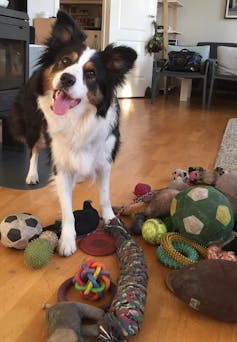Anyone who has lived with dogs will know their ability to learn the meaning of words, even words you don’t want them to know. How many times have you had to spell the words “walk” or “dinner” to avoid a burst of excitement?
Previous research has investigated how non-human animals, including chimpanzees, sea lions and rhesus monkeys, learn words. But a paper now published in the journal Nature shows that some dogs learned the name of a new object after just four listening sessions, an ability previously thought to be limited to humans.
The researchers found that this ability was uncommon among all the dogs studied, and instead it may have been limited to a small number of “talented” or well-trained individuals. So how do you know if your dog is a genius?
The study is simple and easy to replicate at home. Just follow the steps the researchers took to see if your dog can learn the names of objects as quickly as possible. But don’t worry if your dog doesn’t have this ability, it could just be because of their breed or previous experience.
Get the Bark Newsletter in your inbox!
Sign up and get answers to your questions.
Whiskey and Virginina
The new study involved a collie named Whiskey, who knew the names of 59 items, and a Yorkshire terrier named Virginina, who knew 42 toys.
The researchers tested each dog’s knowledge of the toy by asking them to take turns carrying each toy. Neither the owner nor the experimenter could see the toy so as not to influence the dog’s choice.
Once it was determined that the dogs knew the names of all their toys, the researchers introduced two new objects, placing each object in turn into a set of known toys. In this test, Whiskey chose a new toy each time. Vicky Nina got it right in 52.5% of trials, which is slightly above chance.
learn new names
In the next part of the study, the dog was shown a toy, told its name, and allowed to play with it. After the names of the two different new toys were repeated four times, the dogs were asked to choose one of the two new toys.
Familiar toys were not included in this part of the test to prevent dogs from choosing the appropriate toy through rejection. If it knows the names of all the other toys, the dog may choose the correct toy because it guesses that the unfamiliar word must mean the unfamiliar toy.
Both dogs chose the new toy more often than chance predicted, suggesting that they did learn the name of a new object quickly. However, their memory declined markedly after 10 minutes and almost completely after 1 hour. This suggests that more reinforcement is required if new learning is to be retained.
Read more: Six tips for caring for a new puppy, according to science
The test involving the new toy was also conducted by 20 volunteers with their own dogs, but the dogs did not show the ability to learn the new name after several hearings.
The authors suggest that the difference between the two dogs’ performance on the test and the volunteer dog means that in order to learn new names quickly, the dogs may need to be very intelligent or have a lot of experience learning names.
smart dog
In these experiments, multiple factors appear to be at work. Importantly, the breed most commonly used in this type of research is the Border Collie, which is purposefully bred to obey commands and very aggressively perform tasks and please the handler. Yorkshire Terriers also love mental and physical stimulation.
Other research groups have conducted similar tests, often using border collies. In 2004, a dog named Rico was found to know the names of 200 different objects, while in 2011, Chaser learned 1,022 unique objects.
Other breeds may just be less interested in playing or holding toys. For example, sight hounds such as Salukis and Greyhounds are bred primarily for hunting or competition and are therefore generally more difficult to train. They may not be interested in toys at all, nor are they very willing to please their owners.
Smart dogs can learn new names quickly.
Both experimental dogs in this study were intensively trained to pay attention to the names and characteristics of toys through play and social interaction. This may make them more likely to notice differences between new and familiar toys, and pay attention to language cues associated with them.
Although their training is not formal, it is still positive reinforcement training and an effective way to teach animals and humans. There is no doubt that these dogs have highly learned their skills.
It is quite possible to teach all dogs to perform tasks, including learning the names of objects. But the extent to which they are willing and able to learn, and perform tasks, depends largely on the breed of dog and the level of motivation an individual dog possesses.
If your pet is an Afghan Hound or a St. Bernard, you shouldn’t expect him to spend hours fetching toys for you interested. On the other hand, if you have a border collie or poodle, their abilities may only be limited by your imagination and dedication to playing with them.

Comments
Post a Comment